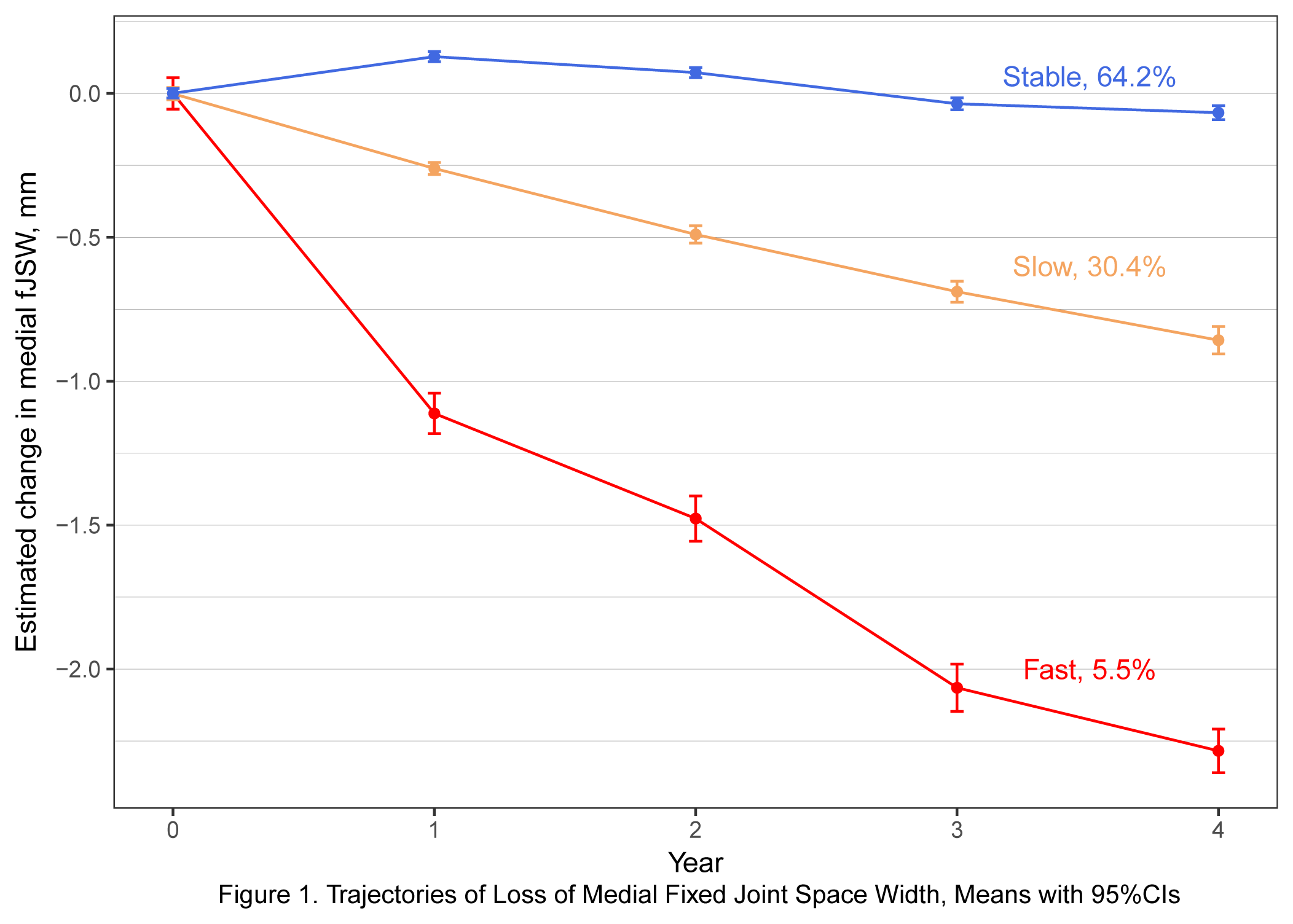Session Information
Date: Wednesday, November 8, 2017
Title: Osteoarthritis – Clinical Aspects II: Structural Progression and Incidence
Session Type: ACR Concurrent Abstract Session
Session Time: 11:00AM-12:30PM
Background/Purpose: Knee OA (KOA) is typically described as a slowly progressive disease, though it is recognized that some patients experience rapid structural deterioration. Identification of knees at risk for rapid structural deterioration would be useful for recruitment to randomized controlled trials (RCTs) and observational studies of KOA. Our objectives were to identify distinct trajectories of medial fixed joint space width (fJSW) loss and estimate the expected percentage of knees in each trajectory based on two measures of KOA severity, Kellgren-Lawrence grade (KLG) and knee pain.
Methods: Osteoarthritis Initiative participants with baseline radiographs centrally read as KLG 0-3, measured medial fJSW (location x=0.250), and participant-reported knee pain severity in the past 30 days based on a numerical rating scale (NRS; 0-10) were selected. One knee per participant was randomly selected when two knees were available, providing a sample size of 3,163 knees. Distinct trajectories of medial fJSW loss over 4 years of follow-up were identified using a group-based discrete mixture model for clustering of longitudinal data. Predicted probability of loss trajectories based on combinations of baseline KLG and NRS were generated with multinomial logistic regression, with NRS categorized as 0, 1-3, and 4-10.
Results: Three distinct trajectories of medial fJSW loss were identified (Figure 1), including knees that remained stable over 4 years (2,030; 64.2%, mean posterior probability of group membership 0.92); knees that experienced slow loss (960; 30.4%, mean probability 0.88); and knees with fast radiographic worsening (173; 5.5%, mean probability 0.94). Among KLG 2 knees, the proportion that experienced slow progression was 28.6-31.8%, while 3.3-7.3% of knees underwent fast progression, depending on the baseline NRS (Figure 2). Among KLG 3 knees, 42.1-49.0% had slow progression, while 6.8-13.0% underwent fast progression. The combination of KLG 3 and knee pain severity 4-10 yielded the highest estimated proportion of knees that experienced subsequent fast progression.
Conclusion: Three distinct trajectories of medial fJSW loss, representing stable, slow, and fast loss of joint space, were identified across the spectrum of KOA disease severity. Recruitment based on KLG and knee pain severity enriches the proportion of expected progressors, both slow and fast, though fast progressors are still not highly represented. Additional risk factors are needed to enrich studies for participants at high risk of rapid structural deterioration.
To cite this abstract in AMA style:
Kwoh CK, Ran D, Ashbeck EL, Duryea J. Distinct Trajectories of Medial Fixed Joint Space Width Loss over Four Years of Follow-up Among Knees with and at Risk for Knee Osteoarthritis [abstract]. Arthritis Rheumatol. 2017; 69 (suppl 10). https://acrabstracts.org/abstract/distinct-trajectories-of-medial-fixed-joint-space-width-loss-over-four-years-of-follow-up-among-knees-with-and-at-risk-for-knee-osteoarthritis/. Accessed .« Back to 2017 ACR/ARHP Annual Meeting
ACR Meeting Abstracts - https://acrabstracts.org/abstract/distinct-trajectories-of-medial-fixed-joint-space-width-loss-over-four-years-of-follow-up-among-knees-with-and-at-risk-for-knee-osteoarthritis/


